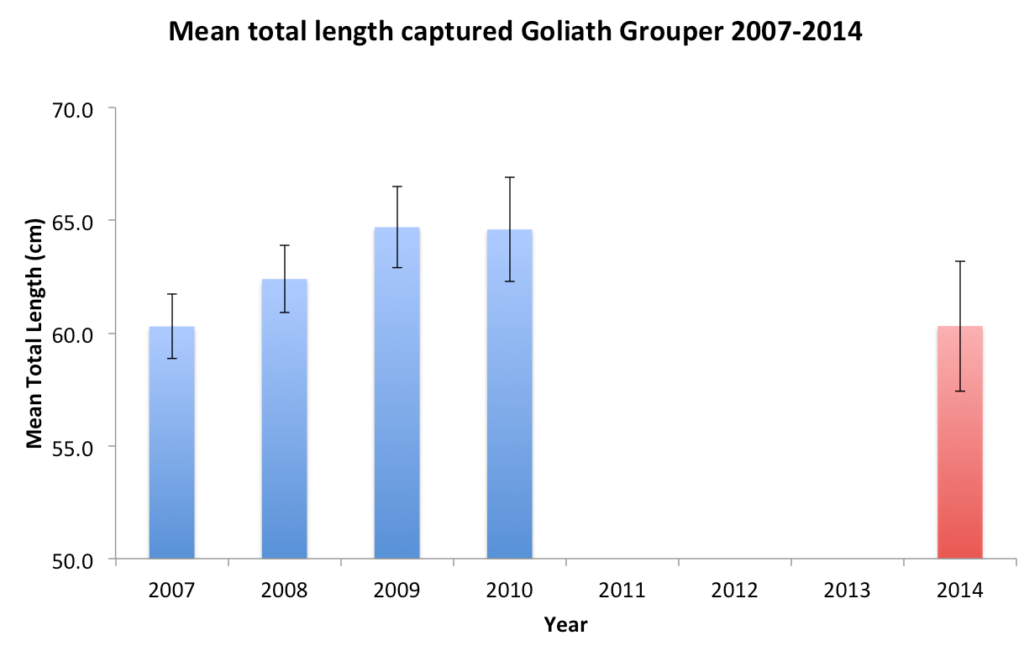The Goliath grouper study is being carried out by Science Director, James Foley, and Research Assistant, Marty Alvarez, to determine the current status of Goliath groupers in Port Honduras Marine Reserve (PHMR) Toledo. Catch data from 2014 was compared with studies conducted by Rachel Graham in 2007-2010 to determine impacts of fishing on Goliath grouper population dynamics, and to inform national policy on this IUCN-listed Critically Endangered species.
Goliath groupers are the largest of all grouper species in the Caribbean, and have been known to live up to 37 years in the wild. They play an important part in maintaining the health of a reef as they predate and balance populations of smaller herbivorous and predatory fish. Also, it is possible larger adults sometimes consume invasive lionfish, highlighting their importance as a potential natural control against lionfish. Being top predators, their survival relies upon healthy smaller fish populations, and their presence therefore indicates a healthy ecosystem.
PHMR is one of only three known nursery sites for Goliath groupers in the wider region, the other two being in Florida and Brazil where full bans are in place on fishing of the species. There is a relatively high abundance of Goliath groupers in PHMR, populations are depleting throughout its adult range throughout the Mesoamerican Barrier Reef, making it essential to protect their nurseries.
The study determined the size range of catch from PHMR by measuring lengths and weights of market catch in Punta Gorda. Results found that although adults can grow up to three metres in length, the majority of fish landed in Punta Gorda measured between 50-95 cm with an average of 60.3 cm. This means that 100% of the catch sampled from PHMR in 2014 had not yet reached sexual maturity as Bullock et al. (1992) describes adult size as 110-115cm for males and 120-135 cm for females. Harvesting juveniles could have implications on Goliath grouper populations in the surrounding area, as some Goliath groupers have been found to migrate as far as Mexico after originating from PHMR.
Foley and Alvarez were also able to compare changes in the average size of caught Goliath groupers over time by comparing their results with previous catch data collected by Rachel Graham between 2007-2010. Results found the average catch size has not changed significantly over time but confirmed that still only juveniles are being caught.
As the population of Goliath groupers in PHMR is naturally skewed towards juvenile fish, the Belize Fisheries Department is willing to set a legal size limit of catch informed by the results of this study. Foley and Alvarez recommend a ~70cm size limit. While this may receive criticism as Goliath groupers mature at over one metre in length, it would also be more likely to be complied with by fishers. Due to the high proportion of juveniles in the local population, a one-metre catch size would effectively be a ban on catching Goliath grouper in the reserve and would therefore likely push Goliath grouper commercial activity underground. With a smaller size limit, Goliath groupers would be protected during 75% of their juvenile phase, leaving them vulnerable to fishing pressure for only the last 25% of their time in PHMR. This would give each individual fish a 75% greater chance of survival, while local fishers would still be able to continue harvesting older juveniles for their livelihoods. No fisher relies solely on Goliath grouper for their income, being only a sporadic supplemental income for most, and so the impact on livelihoods is expected to be modest.
The graph below shows the mean length of goliath groupers measured over an eight-year period. The red bar represents the results collected from TIDE’s goliath grouper study (Goliath_Grouper_Report_TIDE_Foley_June_2014)
It is hoped that by reducing fishing pressure, Goliath groupers will have a 75% greater chance of reaching maturity, with increases in abundance seen in 5 – 10 years. By increasing the population of juveniles, more individuals can migrate to other areas around Belize and Mexico.

